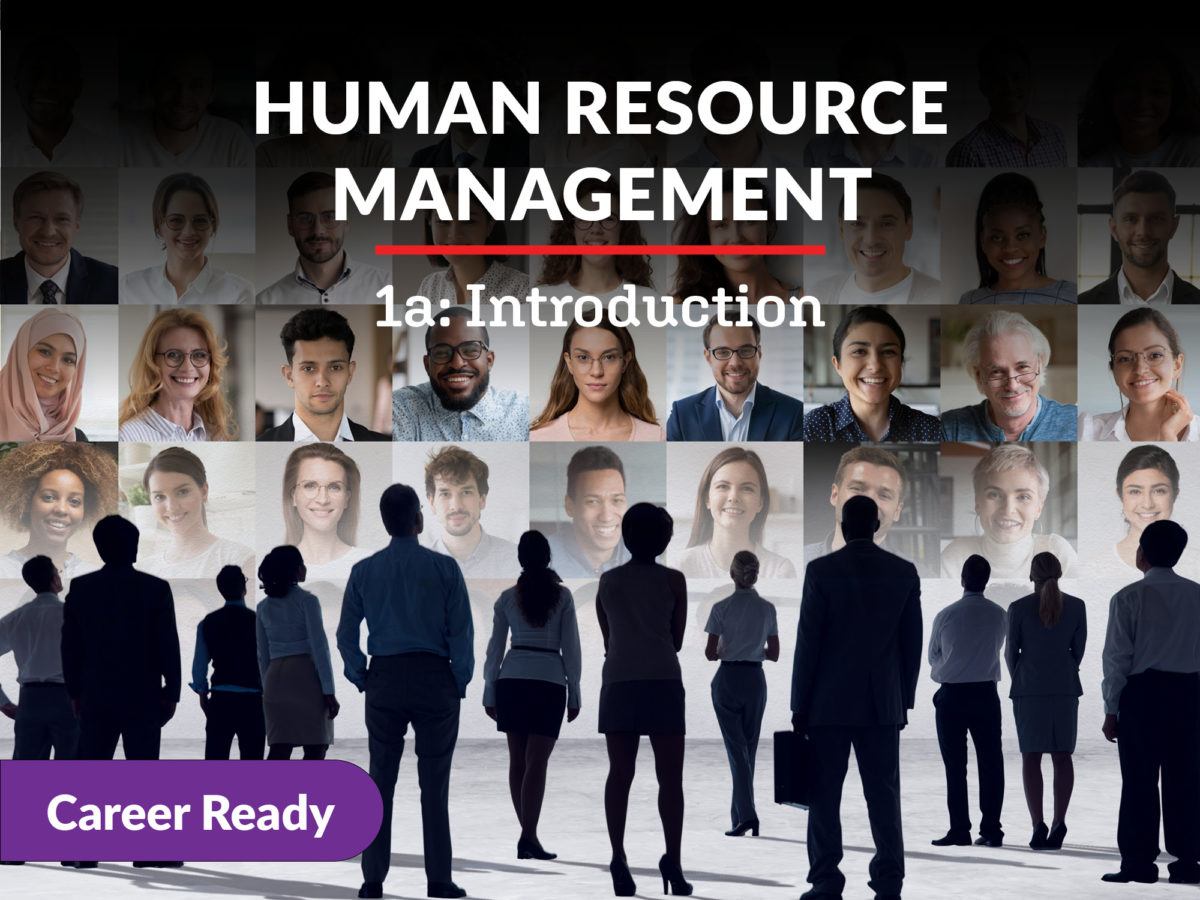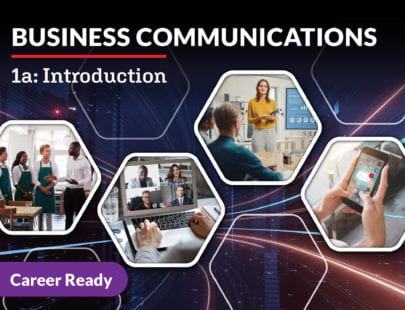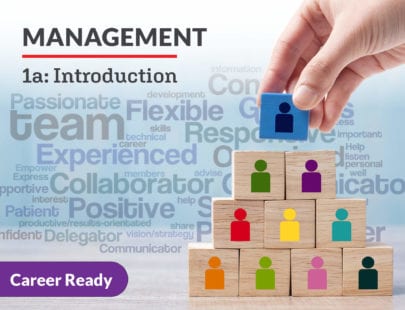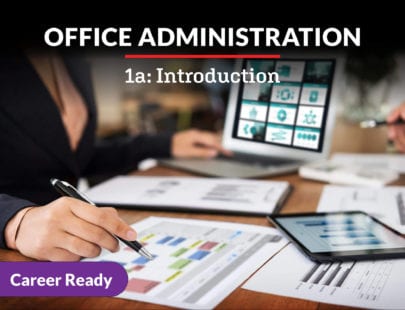
Human Resource Management 1a: Introduction
Are you ready to step into a critical leadership role that oversees the development of every successful business’ most valuable resource? In this course, you will wear the shoes of a Human Resource Management (HRM) professional and will learn how to build and manage a team to help a company reach its goals. You will also explore and perform some of the key responsibilities of a HRM professional: research, interviewing, reporting, recruiting, hiring, assessing employees, and more! Are you ready to help develop invaluable human resources that are the heart of a company and help your company thrive? Learn how to create a winning culture through human resources!
Units at a Glance
Unit 1: Introduction to Human Resource Management
What would a business be without its employees? The workforce brings ideas to life, and humans get the job done. Humans are the most valuable resource for many employers. Human Resource Management (HRM) involves the creation and development of that essential resource—the employees—making HRM a critical part of any business. Students who want to do meaningful work that impacts the company’s bottom line may enjoy learning about how to effectively build and manage a team of human resources.
What will you learn in this unit?
- Define “human resource management” and identify its role in an organization
- Describe the everyday functions of an HRM professional
- Explain the role of HRM in the development of a company culture
- Discuss the evolution of the work environment and its resulting challenges for HRM professionals
Unit 2: HRM Planning and Strategy
Have you ever taken a road trip with friends or family? If so, you might recall that each time you drive to a new place you need to consult a map or some directions in order to find your way. The same is true for a business, especially if it is brand new. A successful business needs a roadmap to guide its future. This map will help the company identify where it is going, how it plans to get there, and how it will know it has arrived. In business we call this map a strategic plan.
What will you learn in this unit?
- Explain the differences between a mission statement and a vision statement and their relationship to company values
- Describe the factors involved in strategic HRM planning
- Identify the stages in the organizational life cycle and conduct a SWOT analysis
- Discuss internal and community strategic partnerships
Unit 3: Job Analysis and Organizational Structure
Organizations are sometimes compared to machines because they have a complex set of components that all come together and operate as a whole. In a business, HRM plays a big part in defining the roles of each piece of the machine by outlining its function and giving it a clear description. When each part knows how to operate, the machine comes together in an organized way to conduct business. This translates to successful workers with clearly defined job descriptions, each playing their part in the overall organizational structure. Let’s learn how to deconstruct this machine and better understand each of its parts.
What will you learn in this unit?
- Perform a job analysis using several different methods
- Use job analysis data to conduct recruiting, hiring, employee performance reviews, training, and career planning
- Create a job description
- Describe the key characteristics of several different organizational structures
Unit 4: HRM and the Law
Managing humans at work is just a smaller version of managing people in society. How is this done effectively, one might ask? Through the operation of laws, of course. The field of HRM is largely shaped by federal and state laws that require employers to respect the rights of workers. Here we will examine how HR professionals can implement workplace policies and procedures that support the civil rights of employees and also meet the legal burdens placed on the employer.
What will you learn in this unit?
- Explain statutory reporting requirements
- Compare and contrast five federal Equal Employment Opportunity Laws
- Describe four federal laws that HR managers must apply when recruiting and hiring employees
- Distinguish between employment at will and an employment contract
- Discuss ethical requirements relating to sexual harassment, employee discipline, substance use, theft, privacy rights and records security
Unit 5: Recruiting For Talent
Recruiting for talented employees looks the same for a business as it might for a college sports team. The boss—and the coach—both want to build an entire team of people with the skills and abilities to perform jobs at the highest level so that everyone wins. HR managers use many different strategies and methods to find and hire workers to complete the roster. Here we’ll examine the playbook on recruiting for the best talent.
What will you learn in this unit?
- Calculate the cost per hire and implement it within a recruitment plan
- Draft a compelling job description to use for recruiting purposes
- Write an effective job posting for any open position
- Understand the available options for recruiting a diverse pool of candidates
- Develop a recruitment plan that complies with federal labor laws
Unit 6: The Selection and Hiring Process
If you asked most people what an HR manager does all day, hiring new employees is likely to be the top answer. Employees are the lifeblood of every business. Highly skilled and engaged workers produce the best results and help companies succeed at whatever they do. For this reason, the selection and hiring process is a fundamental role of every human resource team. Here we’ll examine the significance of each element in this process and how to hire great employees while staying compliant with the law.
What will you learn in this unit?
- Create a job application
- Describe different types of pre-employment tests commonly used by HRM professionals
- Compare and contrast behavior-based interviews, competency-based interviews, and situational interviews
- Review a candidate’s resume for a quick determination about their basic eligibility for the job
- Write a job offer letter to the candidate of your choice
Unit 7: Managing Compensation and Benefits
Have you ever heard the expression about missing the forest for the trees? It means sometimes we get too caught up in the small details and overlook the big picture. Well, managing compensation and benefits for a big company requires the HRM team to see both the forest and the trees. HR must evaluate each and every job role and decide what that job is worth. At the same time, it also has to consider the big picture when creating an overarching system of benefits to serve all employees in the same way. This unit will examine both the details and the whole picture of developing and administering a comprehensive compensation and benefits plan.
What will you learn in this unit?
- Conduct a salary survey and establish pay ranges for each position
- Explain the differences between different types of pay such as hourly, salary, bonus, and commission
- Identify certain benefits that employers are legally required to provide for employees
- List and explain the ins and outs of different discretionary benefits such as retirement plans, health insurance, and paid time off
- Describe the elements of payroll and benefits administration
Unit 8: Performance Management
Human resources (i.e., workers) need to be monitored just like all other company resources. Consider a company’s computer systems. Periodically, computers need to be updated or even replaced if they are not current and don’t work properly anymore. Someone needs to track each computer to make sure it performs effectively or if it needs anything to do its job better. The same is true of the people within a company, and this process is referred to as performance management.
What will you learn in this unit?
- Define the performance management system and describe three key elements of successful performance management
- Explain the main components of the performance planning phase
- Identify and discuss six methods of performance monitoring and employee development
- Understand the purpose of employee appraisals and compare and contrast three types of appraisals
- Describe ways of recognizing strong performance and addressing performance in need of improvement
Required Materials
Physical
- Art supplies
- Digital camera
- Video recording device
- Physical props (toy bricks, candy pieces, cereal, etc.)
Software
- Word processing software
- Presentation software
Optional
- Graphic design software
- Screen recording software
- A person to interview
- Volunteer(s) to act in a skit
- Audio recording device



